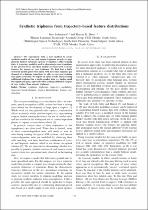JavaScript is disabled for your browser. Some features of this site may not work without it.
- ResearchSpace
- →
- Research Publications/Outputs
- →
- Conference Publications
- →
- View Item
| dc.contributor.author |
Badenhorst, J

|
|
| dc.contributor.author |
Davel, MH

|
|
| dc.date.accessioned | 2016-08-22T11:36:42Z | |
| dc.date.available | 2016-08-22T11:36:42Z | |
| dc.date.issued | 2015-11 | |
| dc.identifier.citation | Badenhorst, J and Davel, MH. 2015. Synthetic triphones from trajectory-based feature distributions. In: Pattern Recognition Association of South Africa and Robotics and Mechatronics International Conference (PRASA-RobTech), Port Elizabeth, South Africa, 25-26 November 2015 | en_US |
| dc.identifier.uri | http://ieeexplore.ieee.org/stamp/stamp.jsp?tp=&arnumber=7359509&tag=1 | |
| dc.identifier.uri | http://hdl.handle.net/10204/8737 | |
| dc.description | Pattern Recognition Association of South Africa and Robotics and Mechatronics International Conference (PRASA-RobTech), Port Elizabeth, South Africa, 25-26 November 2015 | en_US |
| dc.description.abstract | We experiment with a new method to create synthetic models of rare and unseen triphones in order to supplement limited automatic speech recognition (ASR) training data. A trajectory model is used to characterise seen transitions at the spectral level, and these models are then used to create features for unseen or rare triphones. We find that a fairly restricted model (piece-wise linear with three line segments per channel of a diphone transition) is able to represent training data quite accurately. We report on initial results when creating additional triphones for a single-speaker data set, finding small but significant gains, especially when adding additional samples of rare (rather than unseen) triphones. | en_US |
| dc.language.iso | en | en_US |
| dc.publisher | IEEE | en_US |
| dc.relation.ispartofseries | Workflow;16011 | |
| dc.subject | Synthetic triphones | en_US |
| dc.subject | Trajectory modelling | en_US |
| dc.subject | Trajectory-based features | en_US |
| dc.subject | Feature distributions | en_US |
| dc.subject | Feature construction | en_US |
| dc.title | Synthetic triphones from trajectory-based feature distributions | en_US |
| dc.type | Conference Presentation | en_US |
| dc.identifier.apacitation | Badenhorst, J., & Davel, M. (2015). Synthetic triphones from trajectory-based feature distributions. IEEE. http://hdl.handle.net/10204/8737 | en_ZA |
| dc.identifier.chicagocitation | Badenhorst, J, and MH Davel. "Synthetic triphones from trajectory-based feature distributions." (2015): http://hdl.handle.net/10204/8737 | en_ZA |
| dc.identifier.vancouvercitation | Badenhorst J, Davel M, Synthetic triphones from trajectory-based feature distributions; IEEE; 2015. http://hdl.handle.net/10204/8737 . | en_ZA |
| dc.identifier.ris | TY - Conference Presentation AU - Badenhorst, J AU - Davel, MH AB - We experiment with a new method to create synthetic models of rare and unseen triphones in order to supplement limited automatic speech recognition (ASR) training data. A trajectory model is used to characterise seen transitions at the spectral level, and these models are then used to create features for unseen or rare triphones. We find that a fairly restricted model (piece-wise linear with three line segments per channel of a diphone transition) is able to represent training data quite accurately. We report on initial results when creating additional triphones for a single-speaker data set, finding small but significant gains, especially when adding additional samples of rare (rather than unseen) triphones. DA - 2015-11 DB - ResearchSpace DP - CSIR KW - Synthetic triphones KW - Trajectory modelling KW - Trajectory-based features KW - Feature distributions KW - Feature construction LK - https://researchspace.csir.co.za PY - 2015 T1 - Synthetic triphones from trajectory-based feature distributions TI - Synthetic triphones from trajectory-based feature distributions UR - http://hdl.handle.net/10204/8737 ER - | en_ZA |






